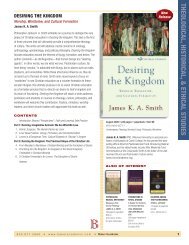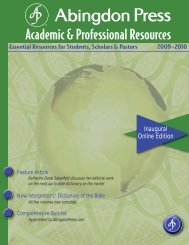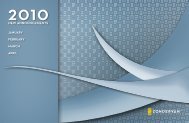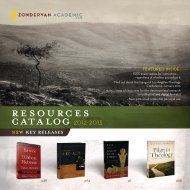koinonia
new releases
new releases
Create successful ePaper yourself
Turn your PDF publications into a flip-book with our unique Google optimized e-Paper software.
#9 Mesopotamia<br />
M<br />
e d<br />
i t<br />
5 BC<br />
Herod the great<br />
Birth of Jesus<br />
5 BC<br />
0<br />
0<br />
augustus<br />
5 AD<br />
5 AD<br />
10 AD<br />
10 AD<br />
roMe<br />
15 AD<br />
15 AD<br />
20 AD<br />
palesTine<br />
Herod philip (northeast)<br />
#9 Mesopotamia<br />
Herod antipas (galilee, perea)<br />
archelaus Ethnarch of Judea, Samaria and Idumea pontius pilate governor of Judea, Samaria, and Idumea<br />
the life of christ<br />
Jesus’ death, burial,<br />
resurrection, p. 84b ascension Isaac and Jacob<br />
Jesus visits temple<br />
Jesus’ public ministry<br />
20 AD<br />
In Egypt, the Twelfth Dynasty, in the period known as<br />
n his sixth and final will Herod designated Archelaus as<br />
the Middle Kingdom, was a time of great prosperity Pyramids<br />
were again being built, administrative and bureaucratic<br />
king of Idumea, Judea, and Samaria; Antipas as ruler in<br />
Galilee and Perea; and Philip as governor of the lands<br />
structures were in place, and the arts and letters flourished;<br />
northeast of the Sea of Galilee However, the Romans did not<br />
indeed, this was the “classical” period of Egyptian literature<br />
give Archelaus the title of king but rather “ethnarch” (meaning<br />
“ruler of the nation”) Archelaus’s ten-year rule (4 BC – AD<br />
were common<br />
Commercial contacts with the Levant, especially with Byblos,<br />
6) was brutal It is little wonder that when Mary, Joseph, and Nazareth: Church of the Annunciation Egyptian surrounded contact with by the hills Levant is reflected in the Story<br />
the baby Jesus returned from Egypt, they avoided returning to rising above Nazareth of Sinuhe (ANET, 18 – 23), a tale of an Egyptian who fled from<br />
A full-scale model of the excavated<br />
Judea, for they heard that Archelaus was ruling in place of his<br />
Egypt to<br />
Galilee<br />
the Levant<br />
boat. This<br />
He<br />
multipurpose<br />
boat could carry about 15 persons total.<br />
first journeyed to Byblos but then<br />
father (Matt 2:19 – 23) Instead, they proceeded to Galilee and<br />
Gezer: standing stones from ca. 1600 BC — the time of the Israelite<br />
sojourn in Egypt — possibly testifying to a covenant/treaty<br />
settled in the village of Nazareth<br />
Herod Antipas (4 BC – AD 39) ruled over both Galilee and<br />
between local Canaanite tribes<br />
Perea Each of these territories had a large number of Jews The<br />
area north of the Sea of Galilee was higher in elevation and was<br />
called Upper Galilee To the south, Lower Galilee was much<br />
more open to outside influence, and its broad, spacious valleys<br />
provided good land for growing grain crops<br />
As Jesus was growing up, Antipas was constructing his<br />
new capital at Sepphoris (3 BC – AD 10), which may have had<br />
a population of 5,000 This city overlooked valuable farmland<br />
114 | Historical Section: The Life of Christ<br />
9780310318576_essential_atlas_cs5.indd 114<br />
e r<br />
tiberius<br />
25 BC<br />
25 BC<br />
30 AD<br />
30 AD<br />
35 AD<br />
35 AD<br />
1/2/13 12:36 PM<br />
0 100 km.<br />
0 100 miles<br />
Beer<br />
60% The evenTs of genesis 14 and<br />
Lahai Roi?<br />
Land<br />
Middle Bronze i (2200 – 2000 Bc)<br />
0 10 km.<br />
of<br />
siTes in The souThern levanT<br />
Seir 0 10 miles<br />
D e s e r t o f P a r a n<br />
Nile Delta: the fertile “land of Goshen,” where Israel<br />
lived in northeast Egypt<br />
Haran<br />
Nineveh<br />
Selected Early Bronze Age cities (3150–2200 B.C.)<br />
Ebla<br />
Middle Bronze I encampments<br />
Historical To Hobah Section: The Patriarchs and the Egyptian Sojourn | 41<br />
Asshur<br />
Middle Bronze I burial grounds<br />
Damascus<br />
Invasion of Kedorlaomer and kings allied with him<br />
Mari<br />
p. 78b The Events of Genesis 14 and Middle Bronze I (2200-2000 B.C.) sites in Palestine<br />
0 10 km.<br />
Damascus<br />
0 10 miles<br />
Dan<br />
Babylon<br />
Nippur<br />
Drehem<br />
Umma<br />
9780310318576_essential_atlas_cs5.indd 41<br />
1/2/13 12:23 PM<br />
0 100 km.<br />
Lagash<br />
0 100 miles<br />
Ur<br />
S e<br />
a<br />
City:<br />
Sodom<br />
Gomorrah<br />
Admah<br />
Zeboiim<br />
Bela (Zoar)<br />
Salem<br />
Nile occurred, and death and destruction were<br />
everywhere<br />
When Abram returned to Canaan, he spent<br />
most of his time in the Negev, with occasional<br />
trips to the Hill Country of Judah and Ephraim<br />
The patriarchs raised sheep and goats and grew<br />
grain crops (see, e g , Gen 13:2, 5 – 7; 24:35; 26:12)<br />
Wells provided water for their families and flocks,<br />
though the control of these water sources was often<br />
disputed Both Abraham and Isaac had conflicts<br />
with the king of Gerar over wells located between<br />
Gerar and Beersheba (Gen 21:25; 26:12 – 33)<br />
The attempt of Abram and his clan to live<br />
in the Bethel/Ai region (Gen 13) seems to have<br />
been somewhat problematic, possibly because<br />
there was not enough grazing land in the area<br />
or because the Canaanites and Perizzites were<br />
hostile (13:7) Lot, Abram’s nephew, chose to<br />
leave the hill country and settle in Sodom, while<br />
Abram remained where he was<br />
The patriarchs visited many places in<br />
Canaan On one of the mountains in the “region<br />
of Moriah” — probably one of the mountains in<br />
9780310318576_essential_atlas_cs5.indd 39<br />
I<br />
?<br />
Ruler:<br />
Bera<br />
Birsha<br />
Shinab<br />
Shemeber<br />
-----------<br />
Melchizedek<br />
City:<br />
Goiim<br />
Ellasar<br />
Shinar<br />
Elam<br />
Ruler:<br />
Tidal<br />
Arioch<br />
Amraphel<br />
Kedorlaomer<br />
Hebron<br />
Megiddo<br />
Bethel<br />
Et-Tell<br />
Salem<br />
(Jerusalem) Kiriathaim<br />
Arad<br />
Bab edh-Dhra<br />
Numeira<br />
Bela<br />
(Zoar)<br />
Feifeh<br />
Khanazir<br />
Hazazon<br />
Beer Resisim<br />
Tamar<br />
Numerous Middle Bronze I<br />
(2200–2000 B.C.)<br />
En Mishpat encampments<br />
(Kadesh)<br />
I T E S<br />
Sea of<br />
Kinnereth<br />
Beth Yerah<br />
Salt Sea<br />
(Dead<br />
Sea)<br />
Ham<br />
Jabbok<br />
Arnon<br />
To<br />
El Paran<br />
GOLAN<br />
Karnaim<br />
Ashtaroth<br />
R.<br />
Gorge<br />
1/2/13 12:23 PM<br />
Black Sea<br />
isaaC and jaCob<br />
p. 84b Isaac and Jacob 77%<br />
(Dan)<br />
Hamath<br />
Qatna<br />
Hazor<br />
Carchemish<br />
Aleppo<br />
R.<br />
Ebla<br />
Mahanaim<br />
Shechem<br />
Route of Isaac’s wanderings<br />
Route of Jacob’s wanderings<br />
Caravan from Gilead<br />
Route of Joseph to Egypt<br />
Joppa<br />
Tyre<br />
Megiddo<br />
Haran<br />
Mari<br />
A r a b i a n<br />
D e s e r t<br />
Sidon<br />
Dothan<br />
Shechem<br />
Aphek<br />
Bethel<br />
Ai<br />
Gezer<br />
Salem<br />
Timnah<br />
Adullam<br />
Gaza Kiriath Arba Mamre<br />
(Hebron)<br />
Gerar<br />
Beersheba<br />
v<br />
Laish<br />
(Dan)<br />
Hazor<br />
Sea of<br />
Galilee<br />
Ephrath<br />
(Bethlehem)<br />
E<br />
Dead<br />
Sea<br />
M<br />
O<br />
d<br />
Succoth<br />
Penuel<br />
Mahanaim<br />
Bible Survey & Reference<br />
biblical studies<br />
NEW<br />
Zondervan Essential Atlas of the Bible<br />
Carl G. Rasmussen<br />
The Zondervan Essential Atlas of the Bible is a concise, handy-sized atlas for Bible students, travelers<br />
to the Holy Land, and any Christian or reader of the Bible curious to find out more about<br />
commonly mentioned places in the Old and New Testaments. It is also an excellent supplemental<br />
textbook for use in classes focused on the Bible, the Old Testament, the New Testament, the<br />
lives and ministries of Jesus and Paul, and historical geography.<br />
The Zondervan Essential Atlas of the Bible features:<br />
• Nearly 200 stunning multidimensional and three-dimensional maps and<br />
full-color images;<br />
• Accurate and up-to-date mapping technologies; and<br />
• Innovative chronological charts and maps covering historical backgrounds,<br />
regions, weather, and roads.<br />
usd $16.99<br />
Softcover • 160 pages<br />
ISBN 9780310318576<br />
january 2014<br />
The Zondervan Essential Atlas of the Bible is ideal for professors looking for an inexpensive<br />
Bible atlas to support courses covering Bible lands, biblical studies, and related topics.<br />
Carl G. Rasmussen (PhD, Dropsie University) is professor emeritus at Bethel University in<br />
St. Paul, Minnesota, and an adjunct professor at Jerusalem University College in Jerusalem. Previously,<br />
he served as dean of the Institute of Holy Land Studies in Jerusalem. He is the author and creator of the<br />
Zondervan Atlas of the Bible.<br />
Caspian Sea<br />
n e<br />
r a<br />
a n<br />
tHe LI f e<br />
of CH RIs t<br />
I<br />
G O<br />
I M<br />
M e d i t e r r<br />
a n e a n S e a<br />
Euphrates R.<br />
Tigris R.<br />
S H I N A R<br />
E L A M<br />
Persian Gulf<br />
A M A L E K<br />
Negev Highlands<br />
A M O R I T E S<br />
W. Farah<br />
Valley of Siddim?<br />
Mt. Seir<br />
H O R<br />
Jordan R.<br />
I T E S<br />
REPHAITES<br />
Yarmuk R.<br />
Z U Z I T E S<br />
E M I T E S<br />
Zered River<br />
M e d i<br />
M<br />
t e r r a n<br />
e d i<br />
Joseph<br />
e a n S e a<br />
t e r r<br />
Laish Damascus<br />
e a n S<br />
Red Sea<br />
a n<br />
to Egypt<br />
To Egypt<br />
e a<br />
Amanus Mts.<br />
Orontes<br />
N e<br />
Jacob Returns<br />
g e<br />
Jacob to Haran<br />
PADDAN<br />
ARAM<br />
Balik R.<br />
Habur R.<br />
Jordan R.<br />
W. Farah<br />
D<br />
e a<br />
G i l<br />
Arnon R.<br />
Zered R.<br />
Tigris R.<br />
Euphrates R.<br />
From Haran<br />
Jabbok R.<br />
To Haran<br />
Contents<br />
Persian<br />
Geographical Section<br />
1. Introduction to the Middle East as a Whole<br />
2. The Geography of Israel and Jordan<br />
3. The Geography of Egypt<br />
4. The Geography of Syria and Lebanon<br />
5. The Geography of Mesopotamia<br />
Historical Section<br />
6. The Pre-Patriarchal Period<br />
7. The Patriarchs and the Egyptian Sojourn<br />
8. Exodus and Conquest<br />
9. Settlement in Canaan and the Time of the Judges<br />
10. Transition to the Monarchy: Samuel and Saul<br />
11. The United Monarchy: David and Solomon<br />
12. The Divided Kingdom<br />
13. Judah Alone<br />
14. Exile and Return<br />
15. The Arrival of the Greeks<br />
16. The Maccabean Revolt and the Hasmonean<br />
Dynasty<br />
17. Early Roman Rule in Palestine<br />
18. The Life of Christ<br />
19. The Expansion of the Church in Palestine<br />
20. The Journeys of Paul<br />
21. The Seven Churches of Revelation<br />
22. Jerusalem<br />
Scripture Index<br />
Subject Index<br />
Historical Section: The Patriarchs and the Egyptian Sojourn | 39<br />
80<br />
Order FREE exam copies (instructors only)













